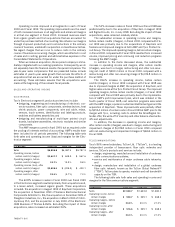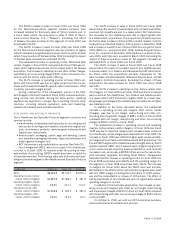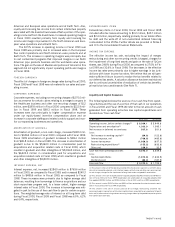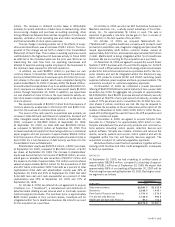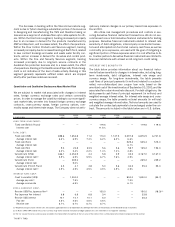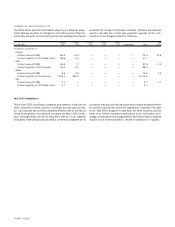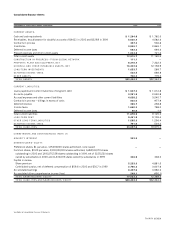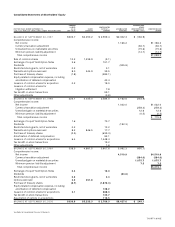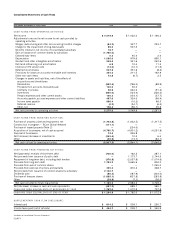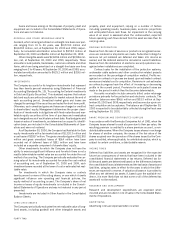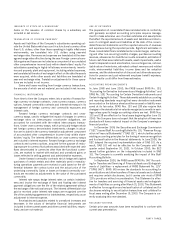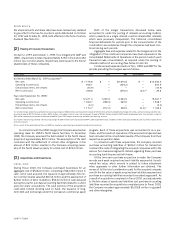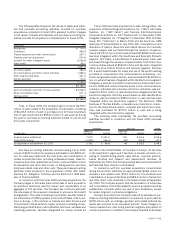ADT 2000 Annual Report Download - page 37
Download and view the complete annual report
Please find page 37 of the 2000 ADT annual report below. You can navigate through the pages in the report by either clicking on the pages listed below, or by using the keyword search tool below to find specific information within the annual report.
THIRTY FIVE
Accounting and Technical Pronouncements
In June 1998 and June 2000, the FASB issued SFAS No. 133,
“Accounting for Derivative Instruments and Hedging Activities” and
SFAS No. 138, “Accounting for Certain Derivative Instruments and
Certain Hedging Activities.” These statements establish accounting
and reporting standards requiring that every derivative instrument
be recorded on the balance sheet as either an asset or liability mea-
sured at its fair value. SFAS Nos. 133 and 138 also require that
changes in the derivative’s fair value be recognized currently in earn-
ings unless specific hedge accounting criteria are met. SFAS Nos.
133 and 138 are effective for fiscal years beginning after June 15,
2000. We do not expect that the adoption of these new standards
will have a material impact on our earnings or financial position.
In December 1999, the Securities and Exchange Commission
(“SEC”) issued Staff Accounting Bulletin No. 101, “Revenue Recog-
nition in Financial Statements” (“SAB 101”), which clarifies certain
existing accounting principles for the timing of revenue recognition
and its classification in the financial statements. In June 2000, the
SEC delayed the required implementation date of SAB 101. As a
result, SAB 101 will not be effective for Tyco until the quarter ended
September 30, 2001. In October 2000, the SEC issued further guid-
ance on the interpretations included in SAB 101. We are currently
analyzing the impact of this Staff Accounting Bulletin.
In September 2000, the FASB issued SFAS No. 140 (“SFAS
140”), “Accounting for Transfers and Servicing of Financial Assets
and Extinguishment of Liabilities – a replacement of FASB State-
ment No. 125.” SFAS 140 revises the standards for accounting for
securitizations and other transfers of financial assets and collateral
and requires certain disclosures, but it carries over most of SFAS
125’s provisions without reconsideration. This Statement is effec-
tive for transfers and servicing of financial assets and extinguish-
ments of liabilities occurring after March 31, 2001. This Statement
is effective for recognition and reclassification of collateral and for
disclosures relating to securitization transactions and collateral for
fiscal years ending after December 15, 2000. We are currently
analyzing this new standard.
Forward Looking Information
Certain statements in this report are “forward looking statements”
within the meaning of the Private Securities Litigation Reform Act
of 1995. All forward looking statements involve risks and uncertain-
ties. In particular, any statement contained herein, in press releases,
written statements or other documents filed with the Securities and
Exchange Commission, or in Tyco’s communications and discus-
sions with investors and analysts in the normal course of business
through meetings, phone calls and conference calls, regarding the
consummation and benefits of future acquisitions, as well as expec-
tations with respect to future sales, earnings, cash flows, operating
efficiencies, product expansion, backlog, financings and share
repurchases, are subject to known and unknown risks, uncertainties
and contingencies, many of which are beyond the control of Tyco,
which may cause actual results, performance or achievements to
differ materially from anticipated results, performances or achieve-
ments. Factors that might affect such forward looking statements
include, among other things, overall economic and business condi-
tions; the demand for Tyco’s goods and services; competitive factors
in the industries in which Tyco competes; changes in government
regulation; changes in tax requirements (including tax rate changes,
new tax laws and revised tax law interpretations); results of litiga-
tion; interest rate fluctuations and other capital market conditions,
including foreign currency rate fluctuations; economic and politi-
cal conditions in international markets, including governmental
changes and restrictions on the ability to transfer capital across bor-
ders; the timing of construction and the successful operation of the
TyCom Global Network; the ability to achieve anticipated synergies
and other cost savings in connection with acquisitions; and the tim-
ing, impact and other uncertainties of future acquisitions.



